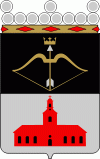Kuopio
 |
Kuopio has a total area of undefined km2, of which undefined km2 is water and half is forest. Though the city's population is spread out undefined PD/km2, the city's urban areas are populated comparably densely (urban area: 1,618 /km²), making Kuopio Finland's second-most densely populated city.
Kuopio is known nationwide as one of the most important study cities and centers of attraction and growth. The city's history has been characterized by several municipality mergers since 1969, as a result of which Kuopio now includes much countryside; Kuopio's population surpassed 100,000 when the town of Nilsiä joined the city at the beginning of 2013. When Maaninka joined Kuopio at the beginning of 2015, Kuopio became Finland's largest milk producing community and Finland's second largest beef producing community. In addition, at the end of the 2010s, Kuopio was noted for numerous large projects, which are the largest nationwide after the Helsinki's metropolitan area. With the large tourist center in Tahkovuori, Kuopio has also grown into a major tourist city. Kuopio Airport, located in the Siilinjärvi municipality, is Finland's fifth-busiest airport, with over 235,000 passengers in 2017.
According to Kuntarating 2017 survey, Kuopio has the most satisfied residents among the 20 largest cities, and according to the 2018 survey, Kuopio is the best city for real estate investors. In the Kuntien imago 2018 survey, Kuopio ranks second among large cities of Finland after Seinäjoki of South Ostrobothnia. In T-media's attraction and influence of the ten biggest cities study in 2021, 2022 and 2023, Kuopio is the second most attractive city in Finland, with Tampere holding the first place.
Kuopio was the European Region of Gastronomy in 2020. It is also known as home of Kalakukko, a traditional food of Savonia, which is why Kuopio is also known by the nickname the "Promised Land of Kalakukko".
Several explanations are behind the name Kuopio. The first is that in the 16th century, a certain influential person named Kauhanen in Tavinsalmi changed his name to Skopa and the people's pronunciation was Coopia and finally Cuopio. The second explanation is that it comes from the verb kuopia, meaning "paw", as when a horse paws the ground with its hoof. A third explanation is that it came from a certain Karelian man's name Prokopij, from Ruokolahti in the Middle Ages. This explanation is the most likely, and is supported by the Research Institute for the Languages of Finland.
Map - Kuopio
Map
Country - Finland
 |
 |
| Flag of Finland | |
Finland was first inhabited around 9000 BC after the Last Glacial Period. The Stone Age introduced several different ceramic styles and cultures. The Bronze Age and Iron Age were characterized by contacts with other cultures in Fennoscandia and the Baltic region. From the late 13th century, Finland became a part of Sweden as a consequence of the Northern Crusades. In 1809, as a result of the Finnish War, Finland became part of the Russian Empire as the autonomous Grand Duchy of Finland, during which Finnish art flourished and the idea of independence began to take hold. In 1906, Finland became the first European state to grant universal suffrage, and the first in the world to give all adult citizens the right to run for public office. After the 1917 Russian Revolution, Finland declared independence from Russia. In 1918, the fledgling state was divided by the Finnish Civil War. During World War II, Finland fought the Soviet Union in the Winter War and the Continuation War, and Nazi Germany in the Lapland War. It subsequently lost parts of its territory, but maintained its independence.
Currency / Language
| ISO | Currency | Symbol | Significant figures |
|---|---|---|---|
| EUR | Euro | € | 2 |
| ISO | Language |
|---|---|
| FI | Finnish language |
| SV | Swedish language |















